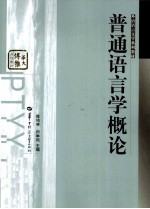图书介绍
普通语言学概论pdf电子书版本下载

- 陈佑林,何举纯主编 著
- 出版社: 武汉:华中师范大学出版社
- ISBN:9787562238768
- 出版时间:2010
- 标注页数:230页
- 文件大小:8MB
- 文件页数:241页
- 主题词:普通语言学-高等学校-教材
PDF下载
下载说明
普通语言学概论PDF格式电子书版下载
下载的文件为RAR压缩包。需要使用解压软件进行解压得到PDF格式图书。建议使用BT下载工具Free Download Manager进行下载,简称FDM(免费,没有广告,支持多平台)。本站资源全部打包为BT种子。所以需要使用专业的BT下载软件进行下载。如 BitComet qBittorrent uTorrent等BT下载工具。迅雷目前由于本站不是热门资源。不推荐使用!后期资源热门了。安装了迅雷也可以迅雷进行下载!
(文件页数 要大于 标注页数,上中下等多册电子书除外)
注意:本站所有压缩包均有解压码: 点击下载压缩包解压工具
图书目录
Chapter 1 Introduction 1
1.1 What is language? 1
1.1.1 Definition of language 1
1.1.2 Distinctive features of language 3
1.2 What is linguistics? 9
1.2.1 Definition of linguistics 9
1.2.2 Principles for linguistic study 10
1.2.3 The scope of linguistics 11
1.2.4 Some basic distinctions in linguistics 13
Exercises 17
Chapter 2 Phonetics 21
2.1 Study of speech sounds 21
2.2 Definition of phonetics 21
2.2.1 Analysis of speech sounds 21
2.2.2 Process of speech production and perception 22
2.3 Speech organs 23
2.4 Production of a sound 24
2.5 Transcription of speech sounds 25
2.6 Classification of English speech sounds 29
2.6.1 Classification of English consonants 29
2.6.2 Classification of vowels 33
Exercises 35
Chapter 3 Phonology 37
3.1 Phonetics and phonology 37
3.2 Phone,phoneme and allophone 37
3.3 Distinctive features 39
3.4 Minimal pairs 40
3.5 Complementary distribution 40
3.6 Phonological rules 41
3.7 Suprasegmental features 42
3.7.1 Stress 43
3.7.2 Tone 44
3.7.3 Intonation 45
Exercises 45
Chapter 4 Morphology 47
4.1 Definition of morphology 47
4.2 Classification of morphology 48
4.3 Morpheme and allomorph 50
4.3.1 Morpheme 50
4.3.2 Morpheme and phoneme 51
4.3.3 Allomorph 51
4.3.4 Types of morphemes 52
4.4 Morphological rules—compounding 56
4.4.1 Compounding 57
4.4.2 Types of compound words 57
4.4.3 Features of compounds 58
Exercises 61
Chapter 5 Syntax 63
5.1 Definition of syntax 63
5.2 Syntax as a system of rules 63
5.3 Sentence structure 65
5.4 Types of sentences 66
5.5 Linear and hierarchical structures of sentences 68
5.5.1 Linear word order of a sentence 68
5.5.2 Hierarchical structure of a sentence 69
5.5.3 Tree diagrams of sentence structure 70
5.6 Syntactic categories 72
5.6.1 Lexical categories 72
5.6.2 Phrasal categories 73
5.6.3 Grammatical relations 74
5.6.4 Combinational rules 75
5.7 Syntactic movement and movement rules 79
5.7.1 NP-movement and WH-movement 79
5.7.2 Other types of movement 80
5.7.3 Moveα—a general movement rule 81
5.8 D-structure and S-structure 81
5.9 Theory of Universal Grammar 82
5.9.1 General principles of Universal Grammar 83
5.9.2 The parameters of Universal Grammar 83
Exercises 85
Chapter 6 Semantics 88
6.1 Definition of semantics 88
6.2 Some major views concerning the study of meaning 88
6.3 Lexical meaning 91
6.3.1 Sense and reference 91
6.3.2 Major sense relations 92
6.4 Sense relations between sentences 97
6.5 Semantic analysis 100
Exercises 102
Chapter 7 Pragmatics 106
7.1 An introduction to pragmatics 106
7.1.1 Definition 106
7.1.2 Pragmatics vs.semantics 106
7.1.3 Context and meaning 107
7.1.4 Sentence meaning vs.utterance meaning 107
7.2 Speech act theory 108
7.2.1 Austin's model of speech acts 108
7.2.2 Searle's classification of speech acts 110
7.2.3 Indirect speech act 112
7.3 Conversational analysis 114
7.3.1 The structural features of conversation 114
7.3.2 Conversational implicature and the Cooperative Principle 117
7.3.3 The Politeness Principle 121
Exercises 129
Chapter 8 Historical Linguistics 132
8.1 A brief history of English language 132
8.1.1 Old English(449—1100) 133
8.1.2 Middle English(1100—1500) 134
8.1.3 Modern English(1500—the present) 135
8.2 Linguistic changes of English 136
8.2.1 Sound change 136
8.2.2 Lexical change 137
8.2.3 Morphological change 141
8.2.4 Syntactic change 141
8.2.5 Semantic change 142
8.3 Language family and language typology 144
8.3.1 Historical comparative linguistics 145
8.3.2 Language family 146
8.3.3 Language typology 149
8.4 Causes of language change 152
8.4.1 Sociological factors 152
8.4.2 Development of science and technology 152
8.4.3 Phonological and grammatical simplification 153
8.4.4 Children's language acquisition 154
Exercises 155
Chapter 9 Sociolinguistics 156
9.1 Variety of language related to the user 156
9.1.1 Notion of variety 156
9.1.2 Dialect 157
9.1.3 Language variety and social class 158
9.1.4 Language variety and race 159
9.1.5 Language variety and sex 159
9.1.6 Language variety and age 160
9.1.7 Idiolect 160
9.1.8 Standard dialect 161
9.2 Variety of language related to the use 161
9.2.1 Register 161
9.2.2 Scales of formality 163
9.3 Standard and non-standard dialects 165
9.3.1 Standard dialect 165
9.3.2 Non-standard dialect 167
9.3.3 Lingua franca 167
9.3.4 Esperanto—an artificial lingua franca 168
9.4 Pidgin,creole,bilingualism and diglossia 169
9.4.1 Pidgin and creole 169
9.4.2 Bilingualism and diglossia 171
Exercises 173
Chapter 10 Psycholinguistics 174
10.1 Language and thought 174
10.1.1 Early views on language-thought relationship 174
10.1.2 Sapir-Whorf Hypothesis 175
10.2 First language acquisition 177
10.2.1 Language acquisition 177
10.2.2 Stages in first language acquisition 178
10.2.3 Children's development of linguistic system 179
10.3 Theories on child language acquisition 184
10.3.1 Reinforcement theory 184
10.3.2 Innate linguistic competence theory 185
10.4 Error analysis and second language acquisition 186
10.4.1 Acquisition vs.learning 186
10.4.2 Second language acquisition vs.first language acquisition 186
10.4.3 Transfer and interference 187
10.5 Types of errors 189
10.5.1 Inter-lingual errors 189
10.5.2 Intra-lingual errors—over-generalization 191
10.5.3 Errors due to communication strategies 192
10.5.4 Performance errors 192
10.5.5 Errors due to cross-association 193
Exercises 194
Answers to Exercises 195
Bibliography 216
An English-Chinese Glossary 220